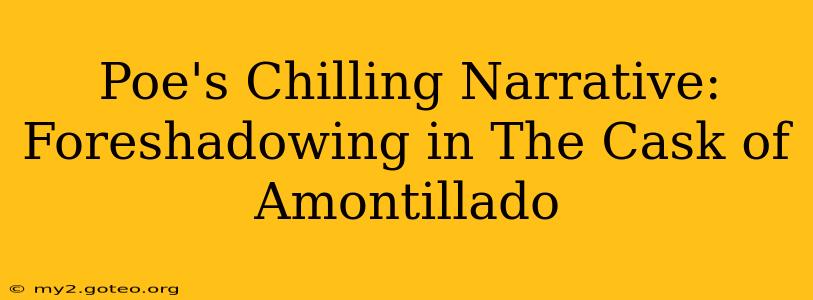Edgar Allan Poe's "The Cask of Amontillado" is a masterclass in suspense, a chilling tale of revenge cloaked in deceptive charm. While the story's shocking climax is undeniably impactful, it's the masterful use of foreshadowing that truly elevates Poe's narrative to a work of enduring literary brilliance. The subtle hints and ominous premonitions scattered throughout the story build a palpable sense of dread, preparing the reader for the horrifying events to come. This exploration delves into the intricate tapestry of foreshadowing Poe weaves, highlighting how these subtle cues amplify the story's impact and contribute to its lasting power.
What is Foreshadowing?
Before we dissect Poe's techniques, let's define foreshadowing. It's a literary device where an author hints at future events, creating suspense and anticipation for the reader. This can be done subtly, through imagery, dialogue, or even seemingly insignificant details, or more overtly, through direct statements or prophecies. Poe, a master of the macabre, expertly employs both subtle and overt foreshadowing in "The Cask of Amontillado" to heighten the tension and amplify the horror.
The Carnival Setting: A Mask of Deception
How does the setting of the carnival foreshadow the events in the story?
The story's setting during Carnival season is itself a potent form of foreshadowing. Carnival, a time of revelry and masks, immediately establishes a deceptive atmosphere. The masks worn by the revelers become a symbolic representation of the deceptive nature of Montresor's intentions. The festive atmosphere contrasts sharply with the brutal act of revenge he is about to perpetrate, highlighting the irony and highlighting the sinister plan hidden beneath the surface of merriment. This juxtaposition foreshadows the brutal act that will occur beneath the guise of friendship and celebration.
Montresor's Ominous Words and Actions: A Blueprint for Murder
Are there specific phrases or actions by Montresor that foreshadow his plan?
Montresor's own words and actions throughout the story are rife with foreshadowing. His repeated insistence on Fortunato's poor health, coupled with his offer of Amontillado, are subtly ominous. These seemingly innocuous comments lay the groundwork for his manipulative plan, hinting at his intention to exploit Fortunato's weakness and pride. Phrases like, "I must not only punish but punish with impunity," reveal the cold calculation behind his actions, foreshadowing the meticulous nature of his revenge. His calm demeanor, even in the face of Fortunato's increasing distress, further underscores his sinister intent.
The Catacombs: A Tomb Awaiting its Victim
How does the setting of the catacombs foreshadow Fortunato's fate?
The descent into the catacombs is perhaps the most powerful example of foreshadowing. The damp, dark, and claustrophobic environment itself becomes a metaphor for Fortunato's impending doom. The very name "catacombs," associated with burial grounds, inherently foreshadows the grim fate awaiting Fortunato. The eerie silence, the dampness, and the chilling atmosphere all contribute to the building suspense, preparing the reader for the gruesome conclusion. The increasingly labyrinthine nature of the catacombs mirrors the complexity of Montresor's plan and the inescapable nature of Fortunato's predicament.
The Brick and Mortar: A Final, Irreversible Act
Does the act of bricking up the wall foreshadow the finality of Montresor's actions?
The final act of bricking up the wall is not only the climax of the story but also a powerful symbol of the irreversible nature of Montresor's revenge. Each brick laid represents the slow, methodical sealing of Fortunato's fate, leaving no room for escape or redemption. This act, foreshadowed by the entire narrative, becomes a chilling testament to the cold-blooded nature of Montresor's vengeance and the lasting consequences of his actions.
Conclusion: A Legacy of Suspense
Poe's masterful use of foreshadowing in "The Cask of Amontillado" is a testament to his skill as a writer of suspense. By strategically placing subtle hints and ominous premonitions throughout the narrative, he creates a powerful sense of dread that resonates with the reader long after the story's conclusion. The chilling effectiveness of the story lies not only in the brutality of the act but also in the skillful anticipation built through these carefully crafted foreshadowing techniques. The lingering unease and the chilling impact of the story are a direct result of Poe's mastery of this literary device, cementing its place as a classic of gothic horror.

